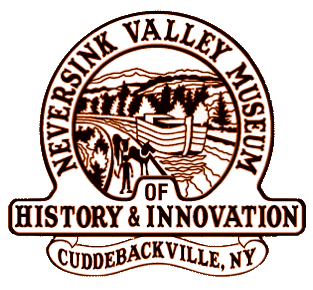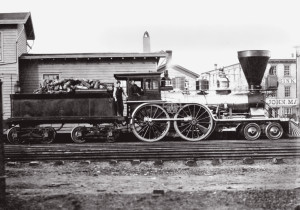The Railroads Change the Dairy Industry
Once canals like the D&H began carrying coal to market, the success of the Pennsylvania anthracite coal fields was assured. In turn, the coal fields were crucial to the financial viability of the anthracite rail carriers which converged around Scranton, Pennsylvania in the mid-19th century. Subsequently, these railroads were responsible for important changes in the dairy industry of the rural areas they crossed. Some of the changes were predictable whilst others were surprising and quite unexpected as we shall see.
The phrase “Dairyland, USA” today brings to mind the State of Wisconsin. However, prior to 1900, this phrase would likely evoke New York. During the 19th century New York was widely renowned for its robust dairy industry. The state was a leader in the production of milk, cheese, and butter. Milk production in New York was first in the nation for an extended period. All during the 19th century and into the early 20th century New York led the nation in the amount of milk it produced. In 1840, for example, New York accounted for 31% of the total value of U.S. dairy products with Pennsylvania coming in a distant second at 9.4%
The first regular supply of butter for the New York City market was manufactured in Orange County and bordering portions of Sussex County, New Jersey. Since Goshen was at the center of this area and was the Orange County seat, this butter became known as “Goshen Butter” and was famous around the country. The Orange county farmers had built up a highly profitable trade in butter and had made a national reputation for it. Butter keeps much better than milk and is well suited for long journeys to market. This was a natural incentive to direct as much milk as possible to butter production.
The booming business in “Goshen Butter” was built in the 1830’s, well before the railroads arrived. The “Goshen Butter” farmers had all agreed that their butter would be sent to New York City on the same day of each year. The day chosen was the second Tuesday in November. During the winter and summer months the butter was put up in firkins. One contemporary account of “the Day of the Big Trip”, describes how the butter would be carted north along the Goshen – Bloomingburg Turnpike on large market wagons to the great Newburgh – Cochecton Turnpike and thence eastward to Newburgh. At Newburgh the butter would be loaded on barges that were then towed to New York City by Hudson River steamboats, arriving at dockside a day later.
“Goshen Butter” was so famous that the National Bank of Orange County, one of the nation’s wealthiest local corporations at the time, printed its currency on yellow paper to commemorate the important role money from the butter trade played in its founding. These banknotes were popularly nicknamed “butter money”. The first President of the bank was George Duncan Wickham, a prominent local investor and one of Orange County’s most powerful men. He saw the value in Goshen Butter and had some involvement in the butter trade. Wickham was also a strong advocate for developing the local transportation infrastructure and was a director of both the D&H Canal Company and the Erie Railroad.
One of America’s first brands was “Goshen Butter”. The butter wholesale house of Van Auken & Cook gained control of the butter trade and established the name “Goshen Butter”. It is due to them that the name became so well-known. The term “Goshen Butter” was particularly well-known in the South. As early as 1812 New York butter wagons were regularly traveling at least as far south as South Carolina. The butter was even available in Savannah, Georgia prior to the Civil War. The blockade of Confederate ports during the Civil War led Southern commentators to lament the cut-off of “Goshen Butter”. After the end of the war, one of the first products shipped to the South was “Goshen Butter”. At the time, correspondents rejoiced that this trade had resumed.
When the railroads finally entered the scene, the genuine “Goshen Butter” trade of Orange and Sussex Counties rapidly declined. The railroads dramatically reduced the time it took to move dairy products to market making milk transport to the city viable. Making butter took more effort than simply shipping raw milk and the “Goshen Butter” farmers abandoned the butter trade in droves. The railroad that would eventually become the Erie Railroad started developing a powerful presence in Orange County in 1841. It passed through Goshen, Middletown and Port Jervis and in 1842 carried the first shipment of Orange County milk to New York City. Access to Sussex County was achieved in 1854 when the Sussex Railroad connected with the Morris & Essex Railroad which had a terminus at Newark. Eventually, the Morris & Essex would become part of the Lackawanna Railroad system. Charges for carrying Orange and Sussex milk were amongst the first sources of revenue for the railroads on which the milk was carried. In a very real sense, the milk business helped establish these railroad lines. The development of this milk trade roughly coincided with the growing reluctance of New Yorkers to drink city milk from cows fed on brewery swill and spent distillery mash. Not withstanding this trade in milk, some butter continued to be shipped by rail to New York City in tubs known as Orange County pails.
The use of the phrase “Goshen Butter” persisted and was applied to butter from a wider geographical area even after the manufacture of the genuine product declined. As late as 1886, butter from the area around Elmira in the Chemung Valley, roughly 150 miles from Goshen, was sold as “Goshen Butter” with the rationale being that the Goshen business had been “transplanted’ to the Chemung Valley when farmers from Orange and Sussex moved to the valley in the 1840’s. Overall New York State butter production was at its peak for 30 years from 1860 to 1890. Orange County was largely responsible for this state of affairs since the factory production of butter was pioneered in Campbell Hall in 1856 when butter maker George Gouge designed, built and ran what has been called the world’s first butter factory in a creamery owned by R. S. Woodhall. Use of factory methods as opposed to the artisanal methods of the farmstead gave New York an advantage in producing large quantities of butter of consistently high quality. In fact, the U.S. Navy used Goshen Butter as its standard.
By 1890 an extensive railroad network had come into being. Beginning that year, the use of mechanical refrigeration by the railroads spread rapidly driven by a distrust of the water that went into the ice harvested in winter. This provided an unprecedented opportunity for New York’s milk industry. It was now possible to send large quantities of raw milk directly to New York City from areas that had before been too far away. Milk that would have gone into butter production was now being sent directly to the city. This contributed to a steep decline in New York State butter production across the board. Between 1890 and 1910 the volume of New York butter produced plummeted by 80%. Whilst the railroads helped create and strengthen the New York milk industry, they also had a significant negative impact on the butter trade and helped cause its decline.
Copyright 2008 by Stephen Skye
Short Link:

